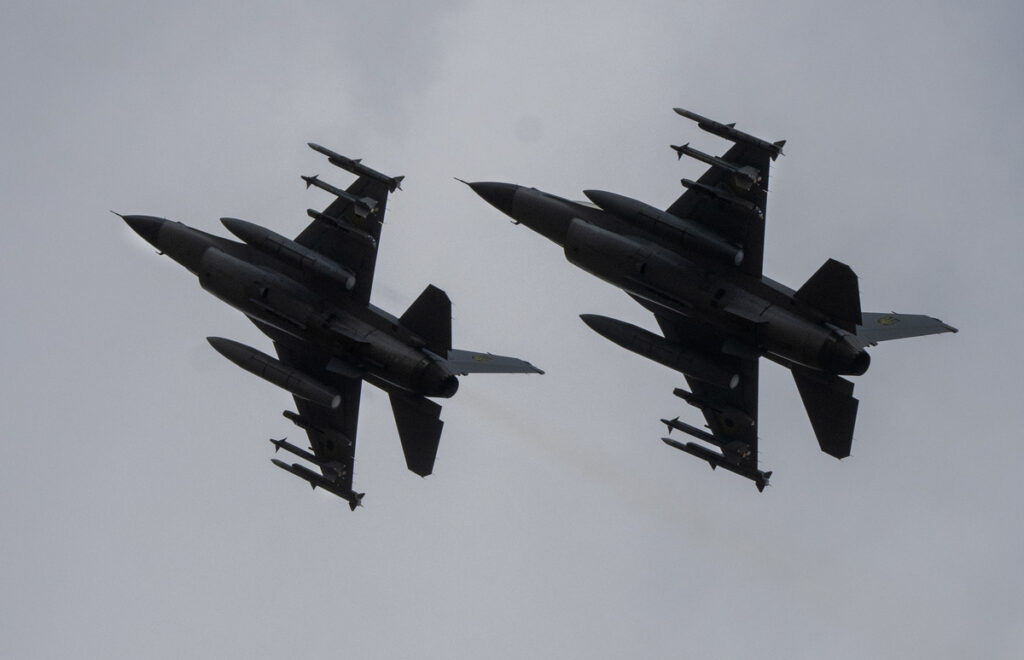Nearly two months after Ukraine’s first batch of Western fighter jets arrived in the war-torn country, the U.S.-made F-16s have largely stayed under the radar, quietly helping out with sorely needed air defense.
In recent days, unconfirmed reports claimed that a Ukrainian F-16 destroyed one of Russia’s Su-34 fighter jets. Newsweek reached out to Kyiv’s air force and the Russian Defense Ministry for comment.
Yet despite the pomp that marked the F-16s taking to Ukrainian skies, relatively little has been heard about the first few jets now in Ukrainian hands.
Lithuania’s foreign minister, Gabrielius Landsbergis, indicated in late July that the jets had arrived. Ukrainian President Volodymyr Zelensky officially confirmed a few days later that the jets were in use by Kyiv’s air force. He did not say how many aircraft had been delivered and were operational, but estimates suggest that about a dozen arrived in recent months.
Denmark and the Netherlands have confirmed that they have sent initial batches of F-16s to Ukraine. More jets from the two countries will be on the way in the next few months, officials said. Norway and Belgium have also pledged F-16s to Ukraine.
Ukraine has lost at least one F-16, which crashed in late August. The pilot, named by Kyiv as Lieutenant Colonel Oleksiy Mes, died while “repelling a massive Russian combined air and missile attack,” Ukraine’s air force said.
Ukraine’s army chief, General Oleksandr Syrskyi, said Mes had “shot down two missiles and he was just attacking, chasing the third cruise missile, using on-board weapons.”
“Unfortunately we lost one of them,” Danish Prime Minister Mette Frederiksen said in late August, referring to Danish-donated F-16s.
But the incidents are among the few publicly acknowledged whispers of the F-16s operating against Russian forces, although the head of the Dutch military, General Otto Eichelsheim, described the jets delivered by the Netherlands as doing a “good job” in late August.
Ukraine’s current F-16 fleet “may not be that numerous and competitive” when pitched against Russia’s jets, “but that’s just a start,” former Ukrainian defense minister, Andriy Zagorodnyuk said.
“If we want Ukraine to be able to stand against Russia effectively, it must have competitive fighter jets at its disposal,” Zagorodnyuk said. “We cannot develop any strategy or campaign plan to fight against Russia without airpower.”
“The key element in this matter is that Ukraine is switching to NATO weapons and, correspondingly, NATO doctrines and concepts,” Zagorodnyuk told Newsweek on Monday.
It is still early for the jets, added retired Air Marshal Greg Bagwell, a former senior commander in the U.K.’s Royal Air Force.
Ukraine has likely adopted a “cautious approach,” Bagwell told Newsweek, adding this is “understandable as they know they will be a target.”
A senior Ukrainian commander said in June that Kyiv would base some of its F-16s outside of the country to avoid Russian strikes on the fourth-generation aircraft. Kremlin spokesperson Dmitry Peskov has said that Russian servicemen have been offered rewards for taking out F-16s.
Ukraine’s F-16s have largely been used in an air defense capacity in recent weeks.
“The F-16s will have been making a relatively unspectacular but very useful contribution to operations,” particularly with air defense, said David Jordan, a senior lecturer in defense studies and co-director of the Freeman Air and Space Institute at King’s College London.
It makes sense for Ukraine to use its few F-16s for air defense, tackling drone and missile attacks, while waiting for further deliveries and getting Ukrainian personnel accustomed to the jets, Jordan told Newsweek: “This isn’t being timid but being very sensible as you wait for the force size to build up.”
Particularly problematic for Ukraine is Moscow’s relentless glide bomb campaign, launching highly destructive bombs from outside the reach of Ukraine’s air defenses.
Zelensky said on Sunday that in just one week, Russia had used more than 900 guided aerial bombs against Ukraine. Kyiv could use its F-16s to attack Russian aircraft launching these bombs.
Ukraine may be using its Soviet jets, like its Su-24, Su-25 and MiG-29, to launch more offensive operations while the F-16s largely hang back for now, Jordan said. Able to launch long-range strikes, he said, it nonetheless makes sense for Ukraine to preserve its F-16s and have the Western jets take over at a later date.
Using F-16s for air defense helps relieve some of the pressure on Ukraine’s scarce stocks of ground-based air defense systems, added James Black, deputy director of defence and security research at the European branch of the RAND think tank.
Weapons launched by F-16s, such as the AIM-9X Sidewinder short-range air-to-air missile or AIM-120 Advanced Medium-Range Air-to-Air Missiles, “may be more cost-efficient to employ against certain incoming targets,” Black told Newsweek.
“This means the F-16 could provide a flexible and economical new tool” for Ukraine’s network of air defenses, Black added.
F-16s are the most significant aid commitment from Kyiv’s Western backers, greenlit by the U.S. in August 2023. For Ukraine’s tired and battered air force, the jets—even in small numbers—provide a boon against Russia’s superior and larger fleet. But F-16s are not game-changers, especially when Ukraine is operating relatively few aircraft.
“Small numbers of aircraft aren’t going to make a massive difference instantly, even if carrying a range of guided weapons, and have to be used judiciously,” Jordan said. “From what we’ve seen so far, that’s what the UkAF [Ukrainian air force] is doing.”
Read the full article here

